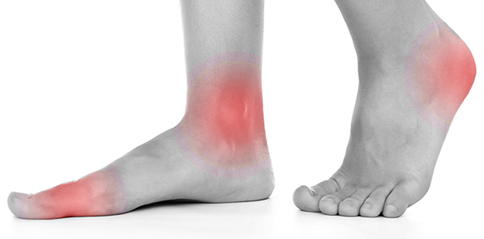Arthritis and Diabetes are two systemic conditions that can have serious effects on the feet and legs if they’re not managed effectively. We take extra care to make your feet as comfortable as possible so you can keep doing the things you love.
Arthritis
Arthritis is a broad term for a number of conditions that destroy the workings of a normal joint. Arthritis causes inflammation in and around joints and can occur at any age. It is not curable, but treatments allow patients to manage pain, stay active, and live fulfilling lives, often without surgery.

There are three types of arthritis that may affect your foot and ankle:
Osteoarthritis
Osteoarthritis is the ‘wear and tear’ arthritis that affects many people after they reach middle age. Over time the smooth, gliding surface covering the ends of bones (cartilage) becomes worn and frayed causing swelling, inflammation and pain in the joints. While this damage that occurs over a person’s lifetime can’t be reversed, we can help the joint function optimally and remove undue stress on the joints to make movement as comfortable and efficient as possible.
Rheumatoid Arthritis
Rheumatoid arthritis is an inflammatory disease where a person’s own immune system attacks and destroys cartilage. This causes pain and swelling in the joints. We complement your standard RA treatment by helping to make your joints as comfortable as possible when you walk and removing any undue strain or pressure. Doing this and reducing pain can have a massive impact on a person’s quality of life and their ability to perform daily activities.
Post-Traumatic Arthritis
Post-traumatic arthritis is caused by the wearing out of a joint that has had some kind of physical injury. This type of arthritis is similar to osteoarthritis as it may develop years after a fracture, severe sprain, or ligament injury.
While developing arthritis is not uncommon as we age, it does not need to severely limit your everyday life or stop you from pursuing the activities that you love. We help you get the best results and reduce your pain so you can reach and exceed your goals!
Diabetes
The effects of diabetes have significant consequences on the feet that carry severe risks to those affected – and unfortunately, the awareness of this in New Zealand is often far too low.
Diabetes results in impairment of both the circulation and the nerves, and therefore sensation. Impaired circulation means a poorer blood supply to all the tissues of the feet and an increased healing time, leaving the body vulnerable to infection. Impaired sensation leaves the feet at risk of undetectable damage, which paired with a slow healing rate and the susceptibility to infection puts them at risk of ulceration, further infection and amputation. In fact, diabetes is the leading cause of non-traumatic amputation in the world.
Unfortunately, this also means that even common foot problems and tasks can be dangerous for people with diabetes due to these increased vulnerabilities and risks. These include:
Corns and Calluses
Corns and calluses are a thickening of the skin that is caused by repeated pressure or rubbing on the same area. If not treated, corns and calluses can act like stones in the shoe, putting pressure on the tissue underneath them. This pressure can lead to bruising, infection or an ulcer. Paired with diabetes, these are much more difficult to treat and take a lot more time. Removing the corns and calluses safely by a Podiatrist significantly reduces your risks.
Foot Ulcers
Ulcers are an area of skin that is broken and taking longer than normal to heal. Not getting treatment for your ulcer can result in them increasing in size and developing an infection or gangrene, which in turn can lead to you losing a limb (amputation). This is especially important in diabetes where impaired healing means it can take months (and even longer) for an ulcer to heal. Each day that an ulcer or wound stays open is another day of massive risk to your feet and legs.
Cracked Skin or Fissuring
Cracked heels don’t just crack the hard skin of the foot but also the soft, vulnerable tissue beneath. If there’s a break in the skin – which you may or may not be able to feel if your sensation is impaired – bacteria can to enter the foot and can cause infection which can have serious consequences.
Toenail Problems
Problem nails can be caused by injury, poor circulation, fungal infection or badly fitting shoes. Ingrown toenails can be painful, red and swollen and can get infected very quickly. Given the toes are the furthest point away from the heart and where circulation is poorest anyway, when paired with the complications of diabetes make any toenail problems that much more serious. Letting your Podiatrist care for your nails and skin is that much more important and also gives you peace of mind that you’re doing the best for not only your feet but your general health.
Diabetic Foot Assessments
Because the effects of diabetes on the feet progressively worsen, having regular diabetic foot assessments check the status of your feet and allow the monitoring of your feet over time, allowing timely advice based on the symptoms you are currently experiencing. We assess your changes in sensation and circulation, alongside your overall foot health.
While the consequences of diabetes on your feet can be severe, they don’t have to be. Checking your feet every day, knowing what to look out for and caring for your feet can greatly minimise the risk of serious foot complications.










